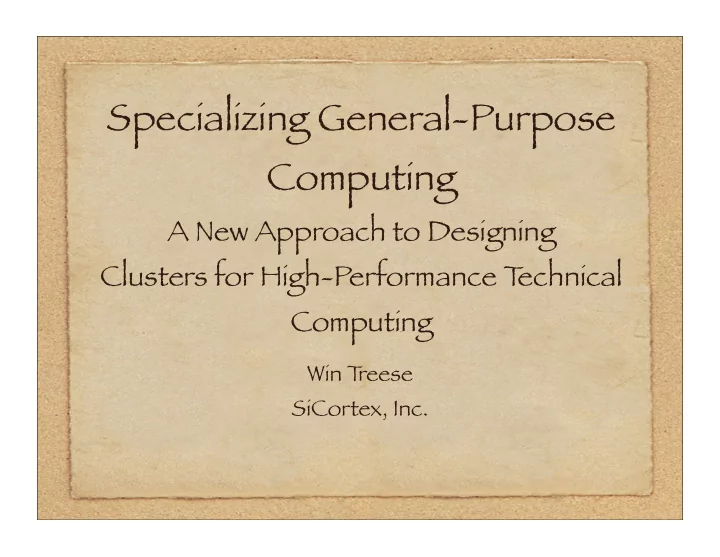

Specializing General-Purpose Computing A New Approach to Designing Clusters for High-Performance T echnical Computing Win T reese SiCortex, Inc.
What the heck does that mean? High-performance computing often uses specialized hardware Supercomputers experiments with graphics processors General-purpose computing doesn’t optimize for technical computing
With some problems... Supercomputers General-purpose computing Expensive Amazing technology Not on the same curve technology curve Optimized for desktop Different programming and enterprise environment applications
A Challenge: The Best of Both Use general-purpose hardware components With a standard programming environment And SYSTEM DESIGN for technical computing
The Roadmap A bit of history A bit about high-performance technical computing (aka “HPTC”) Linux clusters for HPTC Designing a new system for HPTC What we are building
A Bit of History The SUPERCOMPUTER
But all is not well in supercomputer land... You have to pay a lot for them You have write your program differently You have to find some high priests to take care of them Supercomputer companies don’t make money
...so let’s use lots of little computers PCs are cheap Linux is free Commodity interconnect (Ethernet) is cheap The (Beowulf) Cluster is born
A Small Visualization Cluster
Some characteristics of high-performance technical computing
Some typical applications Climate and weather Finite element analysis models Fluid dynamics Geophysics Life sciences analysis Complex financial and simulation modeling T op-secret stuff Mechanical design ...and many others
What are they like? Can run for weeks Large data sets (input and output) Consume all the cycles you can afford Many are in Fortran! Not very cache-friendly ...but also in C, C++, Java, Perl, Python, etc. Parallelism often demands good communications
The Market for HPTC HPTC is now mainstream computing! Over $6 billion in Linux cluster hardware sales in 2006 Petascale computing is hot for research, but there is a real market now for teraflops
Linux Clusters and High-Performance T echnical Computing
So clusters are great, right? Cheap, because they Interconnect (Ethernet) use cheap PCs is cheap Expandable Emerging de facto standards Easy to get started Linux Software is free Message Passing They ride the desktop/ Interface (MPI) server technology curve C, Fortran, etc.
...but not perfect Computational Interconnect is slow: efficiency is often low XXX microseconds for MPI on Ethernet Use lots of power ...or expensive: using Generate lots of heat Infiniband can increase the price of a node by Many parts to fail 50% ...with a desktop MTBF design
And software rules! Software investment is the significant cost Replace the cluster, but keep the software What if we redesign the system with the same programming interface?
Designing a New System for High-Performance T echnical Computing
A Design Challenge 1000 nodes in this box ...all running Linux 6' Near-microsecond MPI latency 5' 5' Air-cooled
The logic of low power Low power ⇒ less heat Less heat ⇒ parts closer together Parts closer together ⇒ shorter wires ⇒ easier high-performance interconnect Less heat ⇒ greater reliability Burn less power waiting for memory
The SC5832 5832 Gigaflops 7776 Gigabytes ECC memory 972 6-core 64-bit nodes 2916 2 GByte/s fabric links 6' about 1 microsecond MPI latency 108 8-lane PCI-Express 18 KW 5' 5' 1 Cabinet
The SC648 648 Gigaflops 864 Gigabytes ECC RAM 108 6-core 64-bit nodes 324 2 GB/s fabric links about 1 microsecond MPI latency 12 8-lane PCI-Express 2 KW 1/2 standard 19” rack
Software It’s just Linux gcc MPI etc. ...even Emacs! All open source
Interconnect fabric Log diameter Multiple paths Cost-effective
A Cluster Node Chip CPU CPU CPU CPU CPU CPU L2 Coherence Engine PCI- DMA Memory Memory Express Engine controller controller Fabric RAM RAM I/O switch
27-Node Module Memory PCIe modules Interconnect Compute fabric nodes
Design for reliability Lower parts count Lower power = less heat = less stress All RAMs have ECC Redundancy in interconnect
Parallel I/O Integrated Lustre cluster filesystem Open source POSIX-compliant Multiple uses Direct-connect storage External Lustre servers RAM-based filesystem
What have we learned? T ake general computing techniques ...with some knowledge about the applications Mix well Powerful and usable computing
Specializing General-Purpose Computing Win T reese SiCortex, Inc. win.treese@sicortex.com or treese@acm.org
Recommend
More recommend